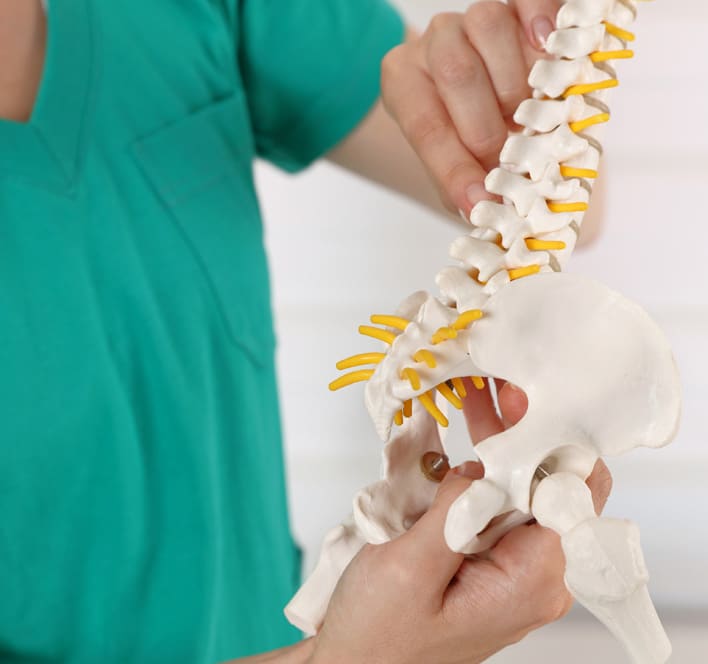When you fracture your coccyx, also known as your tailbone, it doesn’t always feel like a serious injury. Unless your fracture is immediately debilitating, you might decide to avoid treatment altogether. However, before you simply waive getting medical treatment, you must consider the potential consequences. What happens if a broken tailbone goes untreated?
If you broke your tailbone and don’t know what steps to take next, NJ Spine & Orthopedic’s pelvic floor physical therapists can help.
Why Does My Tailbone Hurt?
Typical reasons for tailbone (coccyx) pain include: pregnancy and childbirth, an injury or accident like a fall onto the coccyx, and ongoing strain on the coccyx, such as prolonged sitting while driving or cycling.
What Happens When You Experience Tailbone Pain from a Fracture?
Coccyx fractures usually occur when you fall rear-first on a hard surface. They can also happen during contact sports, childbirth, or other situations that expose your tailbone to trauma. Some common symptoms you may experience if you fracture your tailbone include:
- Pain in your lower back
- Pain in your buttocks
- Swelling in the coccyx area
- Pain or discomfort when sitting
- Pain during urination or bowel movements
- Leg numbness and tingling
- Chronic nagging pain
Your coccyx is a small triangular-shaped bone at the base of your spine. It’s made up of fused vertebrae, and it’s connected to muscles in the area just above the center of your buttocks. When you sustain a coccyx fracture, your pain may feel like a dull ache, a sharp, intense pain, or even severe pain. It may increase when you attempt certain actions or activities, such as:
- Sitting or standing for long periods
- Leaning back when sitting
- Rising from a seated position
- During bowel movements or urination
- During strenuous activities or sports
Coccydynia, the medical term for coccyx pain, varies depending on the severity of the injury and the injured person’s physical condition. With proper treatment and medical follow-up, the pain usually fades over time. However, without proper medical attention and treatment, pain and related difficulties sometimes worsen over time.
What Happens When You Don’t Seek Medical Treatment?
With rest and proper treatment, broken tailbones can heal within weeks or months following the injury. However, for others, the condition usually requires medical attention for optimum recovery. Unless you are experiencing severe or chronic pain, physicians usually recommend nonsurgical treatments. Some conservative treatment options before surgery include:
- Rest
- Icing or heating your back, depending on your symptoms
- Coccygeal cushions for relief while sitting
- Over-the-counter pain relievers
- Walking and back strengthening exercises
- Outpatient treatments, such as nerve blocks, massage therapy, physical therapy, or lidocaine/corticosteroid injections
Without proper medical care, you may continue to suffer due to pain and discomfort. If your symptoms persist, worsen, or linger indefinitely, you should consult with your doctor. Together, you can decide if conservative treatment is still the best option.
Untreated tailbone injuries can lead to pelvic floor dysfunction, where the pelvic floor muscles, which attach around the tailbone, are affected. This dysfunction can manifest as pain with intercourse, urinary incontinence, and pain with bowel movements, significantly impacting one’s quality of life.
Surgical Intervention and Physical Therapy for Tailbone Injuries
If you experience chronic or disabling pain, your coccyx fracture has likely healed improperly. If conservative treatment doesn’t help you manage your pain, your surgeon may recommend a partial or complete coccygectomy. During the surgery, the doctor removes either a portion of your coccyx or the whole thing. Not everyone chooses to undergo coccyx surgery. For those who do, this procedure ultimately eliminates their chronic pain.
Traditionally, surgeons have performed coccygectomies as inpatient surgeries. The patient receives general anesthesia and remains unconscious during the procedure. The patient may have to remain in the hospital for several days but will be free to go home afterwards.
Get Relief From Chronic Tailbone Fracture Pain at the NJ Spine & Orthopedic Surgery
If you’ve had only minimal success managing your tailbone pain with conservative treatment, we offer effective treatment options. At the NJ Spine & Orthopedic, our skilled surgeons provide life-changing surgical solutions, advanced technologies, and state-of-the-art care. We have also performed numerous coccyx removal surgeries, and afterwards our patients resumed their daily lives without chronic pain.
Our surgeons work diligently to provide serious recovery solutions for your tailbone pain or fracture. We will design a personalized treatment plan to meet your needs and provide pain relief that allows you to get back to your normal routine as quickly as possible. If you’re dealing with a broken coccyx or some other painful orthopedic condition, contact us through our contact form or call us at (866) 553-0612 to schedule a consultation today.

